Quick summary:
- It is very difficult to hit a ball over the net at Top Golf
- For you, me, and anyone you know who is a long hitter, no shot.
- For anyone you know who plays professional golf, no.
- For a long-hitting pro golfer, from the top floor, using a ball superior to a TopGolf ball, it’s very plausible.
- For a competition-level long driver, it’s very likely.
- Below is an example of the model – many more included under ‘Results’
Assumptions:
- TopGolf dimensions are 250 yards to the back of the net, which is 150 feet tall
- These are perfectly straight drives and all spin is backspin
- We are hitting TopGolf balls, unless specified otherwise – I apply a penalty to ball speed, launch °, and spin as described below
- We are at sea level, unless specified otherwise
- TopGolf balls have similar aerodynamics to regular balls
Methods and reasoning:
- I am using OptimalFlight, a model created by Todd M. Kos of Quality Golf Stats, to model flight based on input trajectory parameters
- A polynomial regression was used to fit these trajectories to a polynomial function, and this regression function was solved for f(x) when x = 250. The input x being distance, and f(x) returning the ball’s altitude (in yards) at that distance. TopGolf nets measure 50 yards high at 250 yards, so if f(250) > 50, the ball will clear the net
- This polynomial regression step was because I couldn’t figure out how to pull the function out of the ball flight model, however our fit line’s r² was 1.00000 so I am not losing any sleep over it
TopGolf balls do not behave the same as regular golf balls. Based on Trackman 4 data I reported here, off driver the ball speed is 4.6% lower, launch is 6.1% lower, and spin is 28.6% higher. These data match my anecdotal experience at TopGolf (I’m not a walking launch monitor but I can tell spin was high and speeds were down a bit). Simulations will be ran using these modified numbers, as these changes in trajectory have a quite significant impact on distance, apex, and the potential to knock one out of TopGolf.
It’s unclear what the dimensions of an average TopGolf are. Some sources describe length as 215 yards, some say 240, some say 250, and some imply 267. With the lack of clarity I’ll assume 250, which is one of the more commonly reported figures online. Most sources agree on a 150 foot fence height. One source quoted a TopGolf spokeswoman at a 170 fence height.
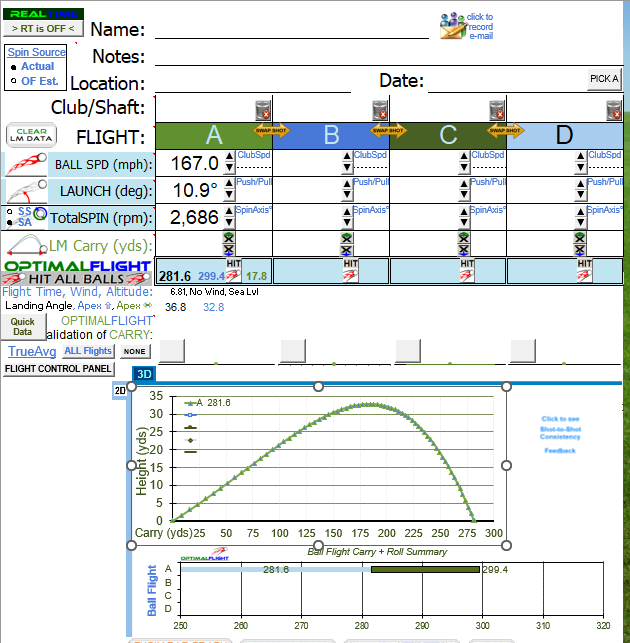
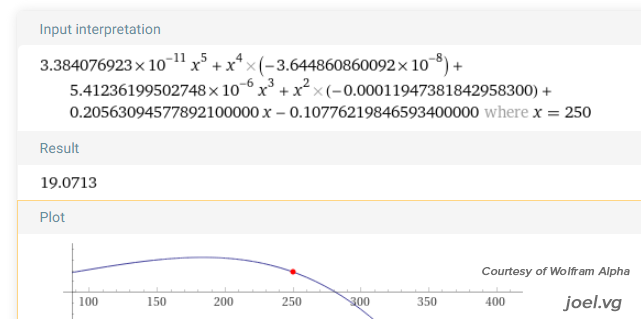
Results:
Average male golfer (14.5 handicap):
- Average male data from Trackman.
- Ball speed: 132.6 mph →126.5 mph with TopGolf ball
- Spin: 3275 rpm → 4212 rpm
- Launch: 12.6° → 11.8°
- Doesn’t even make it to the net so I didn’t waste my time with a polynomial regression or drawing a net on this graph.
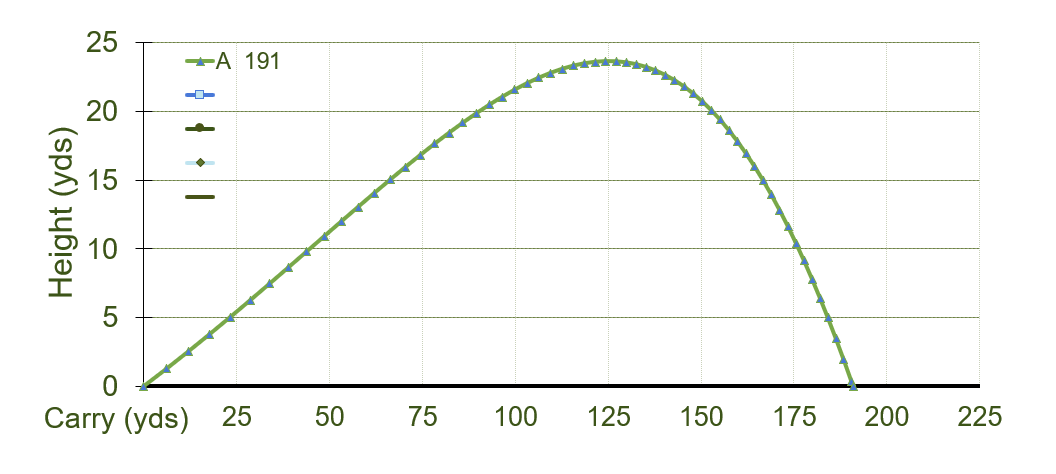
Average female LPGA Tour driver:
- Average LPGA Tour launch parameters from Trackman
- Ball speed: 140 mph → 133.6 mph
- Spin: 2611 rpm → 3358 rpm
- Launch: 13.2° → 12.4°
- Her ball does not make it to the net, excluding roll.
Average male PGA Tour driver:
- Average PGA Tour launch parameters from Trackman
- Ball speed: 167 mph → 159.3 mph with TopGolf ball
- Spin: 2686 rpm → 3454 rpm
- Launch: 10.9° → 10.2°
- His ball intercepts the net at 10.0 yards of height. Closer!

Typical / good drive from Rory McIlroy:
- As of March 12th, 2023, Rory’s average driver ball speed in competition is 184.6 mph. In 2017 Rory tweeted his launch monitor numbers, including a ball speed of 184.1 mph, so I think this is a good enough approximation of his current average. This likely represents a better than average strike given the carry and total.
- Ball speed: 184.1 mph → 175.6 mph with TopGolf ball
- Spin: 2523 rpm → 3245 rpm
- Launch: 12.5° → 11.7°
- His ball intercepts the net at 34.1 yards of height. The first to threaten it!
- This shot would have carried 297.9 had its flight been unobstructed. Had it been a normal ball rather than a TopGolf ball, this carry would have been 320-330 at sea level.
OK, What if Rory brought a TP5x or ProV1 to TopGolf and hit that, and he’s also on the 3rd floor??
- Same input parameters as above, I just did not apply the speed / spin / launch penalties of a TopGolf ball
- 184.1 mph, 2523 rpm, 12.5° launch
- I made the assumption that the hitting surface of the top deck is 30 feet from the ground level. It may be higher but I do not have any numbers on this.
- Just mere inches short!
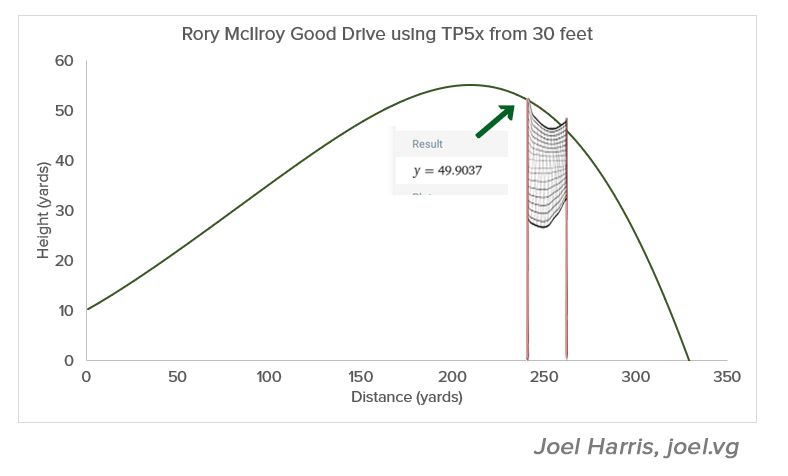
Great strike from 2022 World Long Drive Champion, Martin Borgmeier:
- Typical for Martin is between 220 and 230 mph, with spin depending on what he is trying to do. I usually see him between 1600 and 2800 depending on a number of factors. For entertainment, I will choose an absolute cannon from him, where he shared his GCQuad parameters.
- Ball speed: 230 mph → 219.4 mph with TopGolf ball
- Spin: 1700 rpm → 2186 rpm
- Launch: 16.0° → 15.0°
- Martin’s drive clears the net by a whopping 20 yards. Unreal.
- Unobstructed, this carries 381.6 at sea level.
So can you hit a ball out of TopGolf? The answer is yes, if you are a world champion-level long driver of the ball– OR an extremely long hitter who:
- A) brings their own balls to TopGolf (this is probably banned, if not criminal)
- B) hits from the top floor
- C) plays at high altitude,
- or likely a combination of at least 2 of these
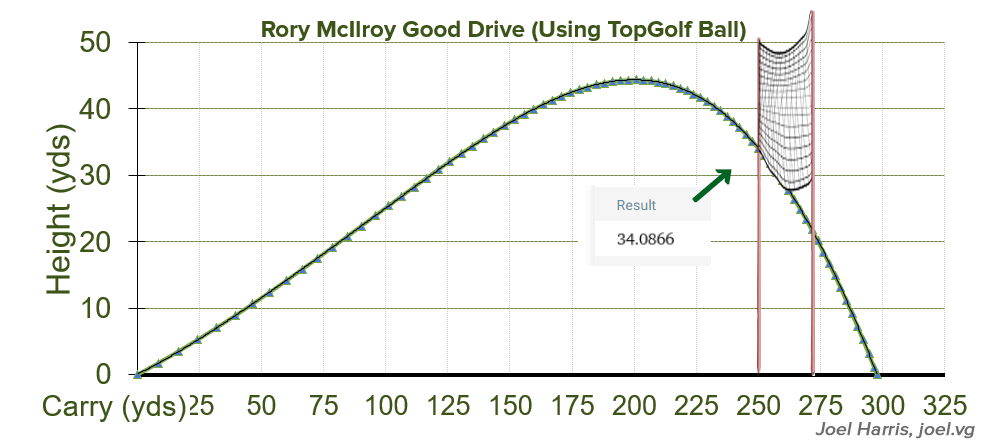

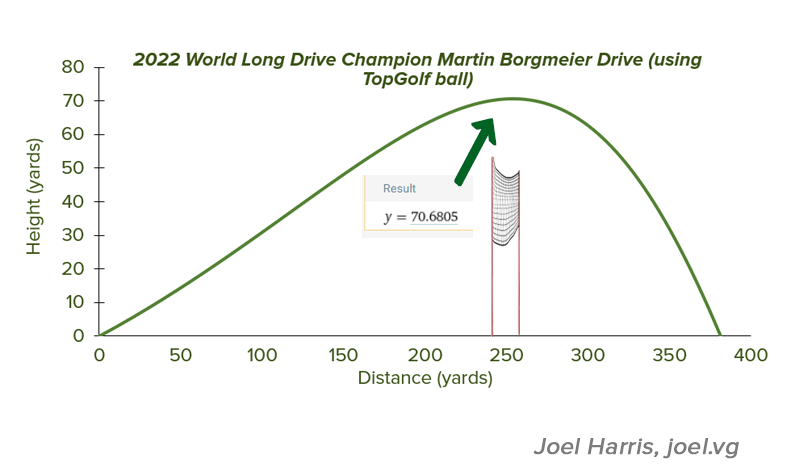
I hit one out of the Top Golf back last week. 2nd swing of the video linked below.
https://youtube.com/shorts/XdlUOO5j7xc?si=At2qPvCdNl4plpF7
Here is a video of my friend hitting it out of the net. With a top golf ball and a regular driver he plays with year round. I just don’t think this model is quite accurate. Or my friend is insane. He is a semi pro Golfer and has entered long drive competitions.